I wrote this standalone essay while finishing my book. It recently appeared online at New Letters (https://www.newletters.org/digital_features/steve-paul-spring-2022/). The photo here of Connell in the midst of a chess game is by Eve Crane and comes from the back jacket cover of Mr. Bridge, published by Knopf in 1969.
By Steve Paul
It wasn’t surprising to learn, early in my research about the underappreciated American author Evan S. Connell, that he harbored a habit for chess. Connell (1924-2013) was a notably introspective and private person, a writer given to long, self-directed intellectual pursuits. So focusing his attention onto a chessboard while hanging out in a bar came to him naturally.
As a denizen of the so-called No Name Bar in Sausalito, Connell often could be found at a quiet, back-corner table nursing a beer or a martini and buried in a mano-a-mano round of chess.
But Connell, whose best-known titles are the minimalist novel Mrs. Bridge (1959) and the maximalist work of Indian-war history Son of the Morning Star (1984), went even further with this obsession. In one of his more challenging yet astutely composed books, Connell employs a game of chess as a recurring device.
At a time when a popular Netflix series, “The Queen’s Gambit,” has brought new attention to the brainy board game, Connell, something of an unacknowledged pacesetter of late twentieth-century literature, can offer a new and wholly unexpected point of entry.
Points for a Compass Rose (1973) was the second volume of a fragmentary, genre-bending literary project that Connell began a decade earlier in Notes from a Bottle Found on the Beach at Carmel. Its form is epic poetry, though it mostly reads like meditative and argumentative prose. Its content is a guided tour of deep human history. Despite Connell’s protestations that he was no poet—and reviews that said much the same—the book was a finalist for the National Book Award in poetry in 1974. Annie Dillard once declared the two books to be masterpieces. “You could bend a lifetime of energy to their study,” she wrote, “and have lived well.”
In Points for a Compass Rose, Connell’s nameless narrators evoke the follies of violence, vanity, and debacle from ancient times to the waging of the Vietnam War, which was still under way at the time he wrote. And embedded periodically from beginning to end are a series of chess moves.
“The colors of a chessboard represent our two conditions,” Connell writes, “which are Life and Death.” He goes on to describe how the white and black chess pieces represent a diversity of men who “contend together and finally experience a mutual fate leveling all ranks.” There are ancient judgments we readers must contend with: “the Queen moves aslant because Woman is greedy and not to be trusted” and “the King…moves in all directions because he is law.”
As he is about to launch into the action, Connell’s spokesman warns: “Play warily, my friend, your opponent is subtle. Take abundant thought of your moves, because the stake is your immortal soul.”
So, in this fractured worldview, much depends on chess, a game imbued with symbol and philosophical meaning. For example, Connell notes in this kaleidoscopic work how a chess game involving a frustrated King Ferdinand of Spain contributed to Christopher Columbus’s mission to find the New World.
Along with the chess moves, another recurring marker in Points for a Compass Rose becomes a litany of horror—the names of German death camps in World War II are followed, one by one, by the number of people who perished there. That sequence represents only a part of the book’s inventory of brutality. So, the stakes in this project are high.
P-K4.
P-K3.
These are the game’s opening moves early on in the book. White King’s pawn steps forward two spaces to the fourth rank. Black King’s pawn responds warily from the other end of the board by moving one square.
The game winds through the book with pairs of moves appearing every 10 to 20 pages or so.
Connell sets up the final move in the text like this (again, in a voice from his unidentified cast of narrators): “Look, I had two sons. One was killed in Asia,// the other’s lost his wits. I regard them as tokens// in a merciless game of incredible complexity// played for the most part by companies of footmen// snatched from the board by mounted knights, bishops// and other powerful opponents who are supervised// from far away by an immured and terrified king.// Tell me, did they have much chance?”
Connell has no mercy for political leaders and warmongers who led us to disasters such as the Vietnam War.
And then this sequence by symbolic “tokens”: P-B4, PxP.
After 14 previous pairs of moves and countermoves, this exchange was the first direct assault, in which a black pawn captures a white one. Drawing from my rudimentary experience with chess, I can surmise that the board is now set up to witness an outright slaughter. Yet, we reach the end of the book with the game hanging in air.
I don’t know how Connell saw it playing out. In “The Queen’s Gambit,” Beth Harmon has bedtime visions of chess challenges to come. Connell did not have the benefit of her phenobarbital habit, nor did he go in for her kind of reckless, drunken bingeing.
Connell left us no specific commentary about his use of the chess game—in his writing or his life—except what can be found in the pages of Points for a Compass Rose. There, the battle on the board serves at least two missions. As a mirror and an omen.

